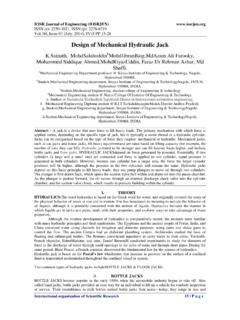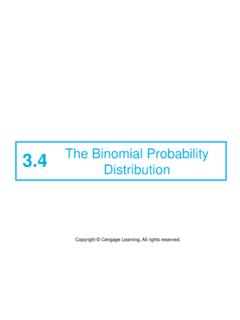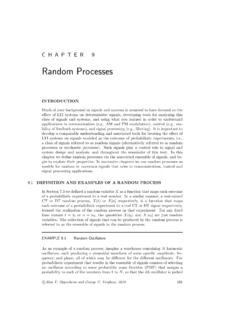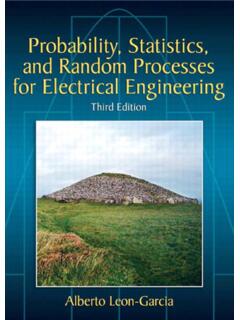Transcription of Chapter 7 FLOW THROUGH PIPES - BU
1 Faculty Of Engineering at Shobra 2nd Year Civil - 2016 Fluid Mechanics, CVE 214 Dr. Alaa El-Hazek 48 Chapter 7 FLOW THROUGH PIPES 7-1 Friction Losses of Head in PIPES 7-2 Secondary Losses of Head in PIPES 7-3 Flow THROUGH Pipe Systems 7-1 Friction Losses of Head in PIPES : There are many types of losses of head for flowing liquids such as friction, inlet and outlet losses. The major loss is that due to frictional resistance of the pipe, which depends on the inside roughness of the pipe. The common formula for calculating the loss of head due to friction is Darcy s one. Darcy s formula for friction loss of head: For a flowing liquid, water in general, THROUGH a pipe, the horizontal forces on water between two sections (1) and (2) are: P1 A = P2 A + FR P1= Pressure intensity at (1). A = Cross sectional area of pipe.
2 P2= Pressure intensity at (2). FR= Frictional Resistance at (2). FR / A = (P1 / ) - (P2 / ) = hf Where, hf = Loss of pressure head due to friction. = Specific gravity of water. It is found experimentally that: Faculty Of Engineering at Shobra 2nd Year Civil - 2016 Fluid Mechanics, CVE 214 Dr. Alaa El-Hazek 49 FR = Factor x Wetted Area x Velocity2 FR = ( f / 2g) x ( d L) x v2 Where, f = Friction coefficient. d = Diameter of pipe. L = Length of pipe. hf = ( f / 2g) x ( d L) x v2 = 4 f * L * v2 ( d2 /4) d * 2 g hf = 4 f L v 2 2 g d It may be substituted for [v = Q / ( d2 /4)] in the last equation to get the head loss for a known discharge. Thus, hf = 32 f L Q 2 2 g d 5 Note: In American practice and references, = f American = 4 f Example 1: A pipe 1 m diameter and 15 km long transmits water of velocity of 1 m/sec.
3 The friction coefficient of pipe is Calculate the head loss due to friction? Solution hf = 4 f L v 2 2 g d hf = 12 = m 2 x x 1 Faculty Of Engineering at Shobra 2nd Year Civil - 2016 Fluid Mechanics, CVE 214 Dr. Alaa El-Hazek 50 The Darcy Weisbach equation relates the head loss (or pressure loss) due to friction along a given length of a pipe to the average velocity of the fluid flow for an incompressible fluid. The friction coefficient f (or = 4 f) is not a constant and depends on the parameters of the pipe and the velocity of the fluid flow, but it is known to high accuracy within certain flow regimes. For given conditions, it may be evaluated using various empirical or theoretical relations, or it may be obtained from published charts. Re (Reynolds Number) is a dimensionless number.
4 Re = v d For PIPES , Laminar flow, Re < 2000 Transitional flow, 2000 < Re < 4000 Turbulent flow, Re > 4000 For laminar flow, Poiseuille law, (f = 64/Re) where Re is the Reynolds number . For turbulent flow, Methods for finding the friction coefficient f include using a diagram such as the Moody chart, or solving equations such as the Colebrook White equation. Also, a variety of empirical equations valid only for certain flow regimes such as the Hazen Williams equation, which is significantly easier to use in calculations. However, the generality of Darcy Weisbach equation has made it the preferred one. The only difference of (hf) between laminar and turbulent flows is the empirical value of (f). Faculty Of Engineering at Shobra 2nd Year Civil - 2016 Fluid Mechanics, CVE 214 Dr. Alaa El-Hazek 51 Introducing the concept of smooth and rough PIPES , as shown in Moody chart, we find: 1) For laminar flow, f = 16 / Re 2) For transitional flow, PIPES ' flow lies outside this region.
5 3) For smooth turbulent (a limiting line of turbulent flow), all values of relative roughness (ks/d) tend toward this line as R decreases. Blasius equation: f = / 4) For transitional turbulent, it is the region where (f) varies with both (ks/d) & (Re). Most PIPES lie in this region. 5) For rough turbulent, (f) is constant for given (ks/d) and is independent of (Re). Doing a large number of experiments for the turbulent region for commercial PIPES , Colebrook-White established the equation: This equation is easily solved employing Moody chart. Faculty Of Engineering at Shobra 2nd Year Civil - 2016 Fluid Mechanics, CVE 214 Dr. Alaa El-Hazek 52 Moody Chart = 4 f & values of ks are provided by pipe manufactures. Pipe Material K, mm Brass, Copper, Glass Asbestos Cement Iron Galvanised Iron Plastic Bitumen-lined Ductile Iron Concrete-lined Ductile Iron Faculty Of Engineering at Shobra 2nd Year Civil - 2016 Fluid Mechanics, CVE 214 Dr.
6 Alaa El-Hazek 53 Example 2: Water flows in a steel pipe (d = 40 mm, k = m, = k/ms) with a rate of 1 lit/s. Determine the friction coefficient and the head loss due to friction per meter length of the pipe using: 1- Moody chart? 2- Smooth pipe formula? Solution v = Q / A = / ( ( )2/4) = m/s Re = v d / = ( ) / = 31840 > 4000 Turbulent flow. 1. Moody chart: k/d = / = & Re = 31840 from the chart, f = hf = 4 f L v2 = ( )2 = m / m of pipe 2 g d 2. Smooth pipe (Blasius equation): f = / = / (31840) = hf = 4 f L v2 = ( )2 = m / m of pipe 2 g d Faculty Of Engineering at Shobra 2nd Year Civil - 2016 Fluid Mechanics, CVE 214 Dr. Alaa El-Hazek 54 Another Solution: Faculty Of Engineering at Shobra 2nd Year Civil - 2016 Fluid Mechanics, CVE 214 Dr.
7 Alaa El-Hazek 55 Example 3: The pipe of a syphon has 75 mm diameter and discharges water to the atmosphere, as shown in figure. Neglect all possible losses. a. Determine the velocity of flow? b. Find the discharge? c. What is the absolute pressure at the point 2? Solution (a) Applying bernoulli s equation between (1) and (3), 2 + 0 + 0 = 0 + 0 + (v23/2g) v3 = m/s (b) Q = v3 x A = x ( ( )2/4) = m3/s (c) Applying bernoulli s equation between (1) and (2), 2 + 0 + 0 = + P2/ g + ( ) P2 = - x (1000 x ) = - N/m2 = - kPa P2abs = kPa where, (Patm = kN/m2) 7-2 Secondary Losses of Head in PIPES : Any change in a pipe (in direction, in diameter, having a valve or other fitting) will cause a loss of energy due to the disturbance in the flow. hs = K (v2 / 2g) The velocity v is the velocity at the entry to the fitting.
8 When the velocity changes upstream and downstream the section, the larger velocity is generally used. Faculty Of Engineering at Shobra 2nd Year Civil - 2016 Fluid Mechanics, CVE 214 Dr. Alaa El-Hazek 56 Obstruction K Tank Exit Tank Entry Smooth Bend 90 Elbow 45 Elbow Standard T Strainer Angle Valve, wide open Gate Valve: Wide Open 3/4 open 1/2 open 1/4 open Sudden Enlargement Sudden Contraction: Area Ratio (A2/A1) = Area Ratio (A2/A1) = Area Ratio (A2/A1) = Area Ratio (A2/A1) = Faculty Of Engineering at Shobra 2nd Year Civil - 2016 Fluid Mechanics, CVE 214 Dr. Alaa El-Hazek 57 Example 4: A pipe transmits water from a tank A to point C that is lower than water level in the tank by 4 m. The pipe is 100 mm diameter and 15 m long. The highest point on the pipe B is m above water level in the tank and 5 m long from the tank.
9 The friction factor (4 f) is , with sharp inlet and outlet to the pipe. a. Determine the velocity of water leaving the pipe at C? b. Calculate the pressure in the pipe at the point B? Solution (a) Applying bernoulli s equation between A and C, Head loss due to entry (tank exit, from table) = (v2C/2g) Head loss due to exit into air without contraction = 0 ZA + 0 + 0 = ZC + 0 + (v2C/2g) + (v2C/2g) + 0 + 4 = (v2C/2g) x {1 + + ( ) } vC = m/s (b) Applying bernoulli s equation between A and B, ZA + 0 + 0 = ZB + PB/ g + (v2B/2g) + (v2B/2g) + - = PB/( ) + ( ) * {1 + + ( ) } PB = - kN/m2 4 f L v2C 2 g d 4 f L v2B 2 g d Faculty Of Engineering at Shobra 2nd Year Civil - 2016 Fluid Mechanics, CVE 214 Dr. Alaa El-Hazek 58 7-3 Flow THROUGH Pipe Systems: PIPES in Series: PIPES in series are PIPES with different diameters and lengths connected together forming a pipe line.
10 Consider PIPES in series discharging water from a tank with higher water level to another with lower water level, as shown in the figure. Neglecting secondary losses, it is obvious that the total head loss HL between the two tanks is the sum of the friction losses THROUGH the pipe line. Friction losses THROUGH the pipe line are the sum of friction loss of each pipe. HL = hf 1 + hf 2 + hf 3 + .. HL = 4f1L1v1 2 + 4f2L2v2 2 + 4f3L3v3 2 + .. 2gd1 2gd2 2gd3 OR: HL = 32f1L1Q 2 + 32f2L2Q 2 + 32f3L3Q 2 + .. 2 g d1 5 2 g d2 5 2 g d3 5 PIPES in Parallel: PIPES in parallel are PIPES with different diameters and same lengths, where each pipe is connected separately to increase the discharge. Consider PIPES in parallel discharging water from a tank with higher water level to another with lower water level, as shown in the figure.








